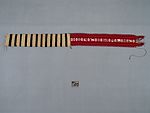Belt
About this object
History of use
The techniques, structures and some of the motifs have pre-Conquest antecedents. This type of textile conveys the most about an individual's ethnicity, sex, age, status and particular history. Wide red belts are woven and worn for many occasions like fiestas and weddings. Some of the images refer to the specific occasion while other motifs appear on almost all belts. Men and women wear belts of this sort for doing heavy work as well because the underbelt functions as a back support. Belts worn for work are usually older belts woven for a long past occasion. Belts are worn by winding continuously around the waist, starting with the underbelt and ending by tying the cords.
Narrative
Bought from Petrona Machaca Quispe and her husband, Faustino Quispe Cruz. She wove the wide red belt for Faustino to wear at their wedding in August, 1987. Her father, Victor Machaca Quispe wove the underbelt about 20 years ago. Faustino wore this belt on the first day of his wedding. Petrona made him a similar belt for the second day of the wedding. She also wove 2 for herself for the wedding.
Cultural context
wedding
Iconographic meaning
The range of motifs refers to local geography and landmarks, ecology, fecundity as well as luck. The six part circle refers to the division of land into six sections on Taquile and the rotation of crops and fallow periods. Between the cow and the horse is a stylized version of the altar erected by the Catholics for the 24th of June fiesta. Between the cow and the house is another altar with flags representing the marriage altar. After the house is a diamond with flags which represents the tortora reed compound built for the families of the bride and groom to sit in during the wedding. After a second horse is a dove with its baby. The serrated diamond is 'cinta lawar' (non-translatable). The rayed diamond is 'chaska' or morning star. The eye shape and zigzag is called 'kenko nawi' or meandering eye.
Specific techniques
Patterned belt: commercial synthetic yarns, z spun and plied 2-s, are retwisted on the drop spindle before warping. The plain stripes are warp-faced plain weave and the central pattern band is double cloth, also warp-faced plain weave, with picked-up designs. The side pattern bands and narrow tie are complementary warp weave with 3 span floats aligned in alternate pairs. Groups of warps at one end are braided in 3 strand oblique interlacing. The belt is woven to size on a continuous warp and the terminal area is braided; stitched to a separately woven underbelt. Underbelt: warps and wefts are sheep's wool, z spun and s plied, possibly 3 strands together. The woven structure is weft wrapping. One 4 selvedge fabric sewn at one end to upper belt. Worn edges are overcast with a separate yarn.
Physical description
Wide red belt with white figurative and geometric motifs is sewn at one end to a stiff, thick belt cross-striped in light and dark shades of natural wool. The non-sewn end of the red belt terminates in 36 braids which are grouped together by a cord knotted to a very narrow woven tie with geometric patterns. Another doubled cord is attached to the non-sewn end of the stiff belt. The red belt has five lengthwise design bands. In the centre, the widest band has naturalistic images of horses, cows, birds and a house alternating with more geometric motifs, principally a six-part circle. Narrow bands flanking the central stripe repeat an eye shape on both sides of zigzag. Pattern bands near the edges have many small motifs, mostly geometric.
Categories
Materials
